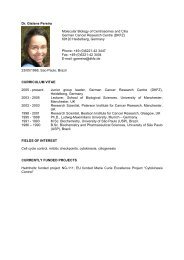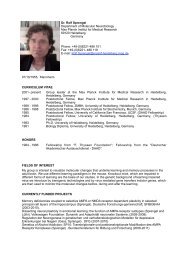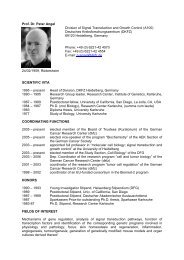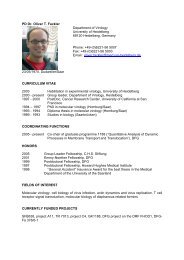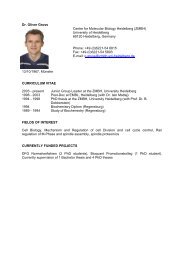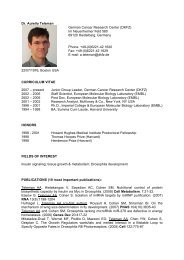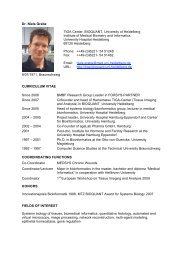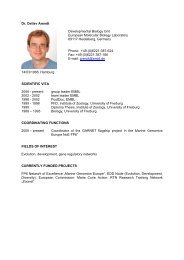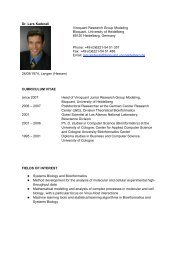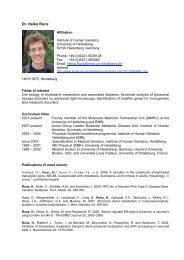Dr. Dirk Grimm University of Heidelberg BIOQUANT D ... - HBIGS
Dr. Dirk Grimm University of Heidelberg BIOQUANT D ... - HBIGS
Dr. Dirk Grimm University of Heidelberg BIOQUANT D ... - HBIGS
Create successful ePaper yourself
Turn your PDF publications into a flip-book with our unique Google optimized e-Paper software.
<strong>Dr</strong>. <strong>Dirk</strong> <strong>Grimm</strong><br />
<strong>University</strong> <strong>of</strong> <strong>Heidelberg</strong><br />
<strong>BIOQUANT</strong><br />
D-69120 <strong>Heidelberg</strong>, Germany<br />
Phone: +49-(0)6221-5451339<br />
Fax: +49-(0)6221-5451481<br />
Email : dirk.grimm@bioquant.uni-heidelberg.de<br />
22/05/1969, Ludwigshafen Group leader<br />
SCIENTIFIC VITA<br />
2007 – now Group leader ‘Virus-Host Interactions’, <strong>University</strong> <strong>of</strong> <strong>Heidelberg</strong>, Germany<br />
2006 – 2007 Research Associate, Stanford <strong>University</strong>, School <strong>of</strong> Medicine, CA, USA<br />
2001 – 2006 Postdoctoral Fellow, Stanford <strong>University</strong>, School <strong>of</strong> Medicine, CA, USA<br />
1999 – 2001 Postdoctoral Fellow, German Cancer Research Center, <strong>Heidelberg</strong>, Germany<br />
1998 PhD (Biology) with Summa cum laude, <strong>University</strong> <strong>of</strong> <strong>Heidelberg</strong>, Germany<br />
1994 Diploma (Biology), <strong>University</strong> <strong>of</strong> Kaiserslautern, Germany<br />
1988 – 1994 Study <strong>of</strong> Biology (Universities <strong>of</strong> Kaiserslautern and <strong>Heidelberg</strong>, Germany)<br />
FIELDS OF INTEREST<br />
Adeno-associated viral (AAV) vectors and their optimization for targeted gene transfer,<br />
Natural interactions <strong>of</strong> human pathogenic viruses with host cells, Cellular RNA interference<br />
(RNAi) mechanisms and their role in viral infection and pathogenesis, Design <strong>of</strong> vector-based<br />
high-throughput RNAi screens for in vivo gene discovery, Development <strong>of</strong> novel clinical<br />
modalities based on AAV/RNAi for the treatment and prevention <strong>of</strong> virus infections.<br />
PUBLICATIONS (10 most important publications):<br />
<strong>Grimm</strong>, D., M.A. Kay. Therapeutic RNAi applications: Is mRNA targeting finally ready for<br />
prime-time ? J. Clin. Invest., in press<br />
<strong>Grimm</strong>, D., K.S. Streetz, C.L. Jopling, T.A. Storm, K. Pandey, C.R. Davis, P. Marion, F.<br />
Salazar, M.A. Kay. 2006. Fatality in mice due to oversaturation <strong>of</strong> cellular microRNA/short<br />
hairpin RNA pathways. Nature 441:537-541.<br />
Akache, B., D. <strong>Grimm</strong>, K. Pandey, S. Yant, H. Xu, M.A. Kay. 2006. The 37/67-kildodalton<br />
laminin receptor is a receptor for adeno-associated virus serotypes 8, 2, 3, and 9. J. Virol.<br />
80:9831-9836.<br />
<strong>Grimm</strong>, D., M.A. Kay. 2006. Combinatorial RNAi: A winning strategy for the race against<br />
evolving targets ? Mol. Ther. 15:878-888.<br />
<strong>Grimm</strong>, D., K. Pandey, H. Nakai, T.A. Storm, M.A. Kay. 2005. Liver transduction with<br />
recombinant Adeno-associated virus is primarily restricted by viral serotype, not vector<br />
genotype. J. Virol. 80:429-436.
<strong>Grimm</strong>, D., S. Zhou, H. Nakai, C.E. Thomas, T.A. Storm, S. Fuess, T. Matsushita, J. Allen,<br />
R. Surosky, M. Lochrie, L. Meuse, A. McClelland, P. Colosi, M.A. Kay. 2003. Pre-clinical in<br />
vivo evaluation <strong>of</strong> pseudotyped adeno-associated virus (AAV) vectors for liver gene therapy.<br />
Blood 102:2412-2419.<br />
<strong>Grimm</strong>, D., M.A. Kay. 2003. From virus evolution to vector revolution: Use <strong>of</strong> naturally<br />
occurring serotypes <strong>of</strong> Adeno-associated virus (AAV) as novel vectors for human gene<br />
therapy. Curr. Gene Ther. 3:281-304.<br />
<strong>Grimm</strong>, D., M.A. Kay, J.A. Kleinschmidt. 2003. Helper virus-free, optically-controllable, and<br />
two-plasmid-based production <strong>of</strong> adeno-associated virus vectors <strong>of</strong> serotypes 1 to 6. Mol.<br />
Ther. 7:839-850.<br />
<strong>Grimm</strong>, D., A. Kern, M. Pawlita, F. Ferrari, R. Samulski, J.A. Kleinschmidt. 1999. Titration <strong>of</strong><br />
AAV-2 particles via a novel capsid ELISA: packaging <strong>of</strong> genomes can limit production <strong>of</strong><br />
recombinant AAV-2. Gene Ther. 6:1322-1330.<br />
<strong>Grimm</strong>, D., A. Kern, K. Rittner, J.A. Kleinschmidt. 1998. Novel tools for production and<br />
purification <strong>of</strong> recombinant adeno-associated virus vectors. Hum. Gene Ther. 9:2745-2760.




